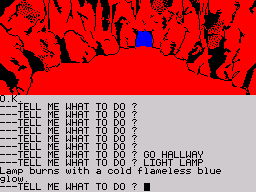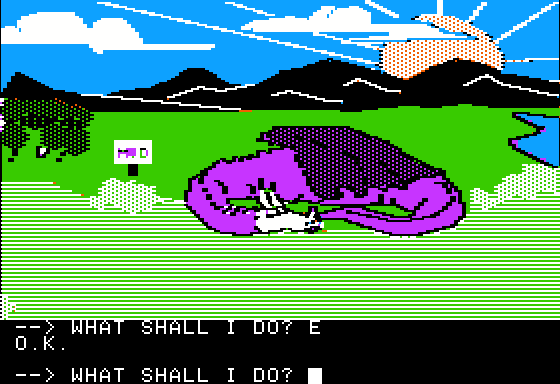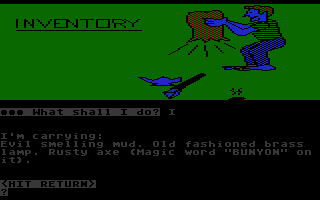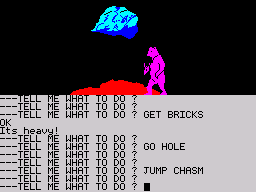Retro Replay Review
Gameplay
Scott Adams’ Graphic Adventure #1: Adventureland presents a classic interactive experience that will appeal to both retro enthusiasts and newcomers curious about the roots of adventure gaming. Gameplay remains faithful to the original text-only Adventureland, relying on simple one- or two-word commands to guide your character through the world. This minimalist parser challenges you to think creatively, experimenting with verbs like “GET,” “USE,” or “CLIMB” to overcome puzzles and progress.
(HEY YOU!! We hope you enjoy! We try not to run ads. So basically, this is a very expensive hobby running this site. Please consider joining us for updates, forums, and more. Network w/ us to make some cash or friends while retro gaming, and you can win some free retro games for posting. Okay, carry on 👍)
The addition of Hi-Res graphics does not alter the core mechanics, but it does enhance immersion. You can toggle between text and visual modes at the press of the RETURN key, allowing you to enjoy atmospheric illustrations while retaining the clarity of textual descriptions. This seamless switch keeps you engaged, whether you prefer to decipher wordy clues or admire pixel art environments.
Puzzles in Adventureland strike a carefully balanced difficulty. Some treasure hunts rely on keen observation—spotting a hidden passage or noticing a subtle hint—while more elaborate sequences demand logical reasoning and inventory juggling. Hints are woven into room descriptions, encouraging exploration and trial-and-error without resorting to brute-force guessing. For modern players seeking a deliberate, paced challenge, Adventureland delivers hours of thoughtful gameplay.
Graphics
Adventureland’s graphical update, under the SAGA banner, boasts Hi-Res images that bring Scott Adams’ world to life. Each scene is rendered in crisp monochrome or limited palette color, depending on your system, capturing the charm of early microcomputer artwork. While not comparable to today’s photorealistic titles, these visuals carry a nostalgic warmth that reinforces the game’s pioneering spirit.
The design team paid attention to detail: flickering torches in underground caverns, a menacing silhouette of a dragon in the lair, and the delicate pattern of a beehive all appear with surprising clarity. The images complement the textual narrative, providing visual cues that sometimes highlight critical objects or passageways you might otherwise overlook.
Text-to-Speech hardware support further elevates the experience for players with compatible gear. Hearing the game’s descriptions read aloud adds an audio dimension that was revolutionary for its time—and still feels novel. Combined with upper- and lowercase display, the presentation reads smoothly and feels more polished than many peers from the early ’80s era.
Story
At its heart, Adventureland is a treasure hunt. You assume the role of an intrepid explorer venturing through forests, ruins, caves, and dungeons in search of priceless artifacts. Although the narrative premise is straightforward, flavor text and environmental details imbue each location with character, from the echoing corridors of an ancient castle to the sunlit clearing where woodland creatures roam.
Encounters with creatures—such as a fire-breathing dragon, a territorial bear, and an aggressive hive of bees—add a sense of peril and unpredictability to your quest. Each adversary forces you to adapt your strategy: distracting the bear with bait, sneaking past the dragon, or fashioning a makeshift bee smoker. These moments punctuate exploration with bursts of tension and reward creative problem-solving.
Though Adventureland doesn’t feature a sprawling plot or branching dialogue trees, its simple premise carries weight through atmosphere and player-driven discovery. The absence of narrative hand-holding lets you craft your own adventure, celebrating each triumph—whether solving a thorny puzzle or narrowly escaping a hungry beast—as a personal victory.
Overall Experience
Scott Adams’ Graphic Adventure #1: Adventureland remains a standout title for anyone interested in the evolution of adventure gaming. Its blend of text-based commands and static graphics showcases a transitional phase in game design—retaining the depth of interactive fiction while flirting with visual storytelling. The result is an experience both nostalgic and historically significant.
While modern gamers accustomed to point-and-click interfaces or real-time 3D worlds may find the parser restrictive, many will appreciate the deliberate pacing and the satisfaction of mastering a simplistic yet robust command system. Adventureland encourages patience, observation, and experimentation, rewarding perseverance with memorable set pieces and triumphant treasure recoveries.
Ultimately, Adventureland is more than a relic: it’s a living artifact that invites players to step into the shoes of early adventurers. Whether you’re exploring aboveground forests or delving into subterranean labyrinths, the game’s timeless charm and clever design continue to foster a sense of wonder and achievement. For fans of retro titles or those seeking a taste of gaming history, Adventureland remains a must-play journey.
 Retro Replay Retro Replay gaming reviews, news, emulation, geek stuff and more!
Retro Replay Retro Replay gaming reviews, news, emulation, geek stuff and more!









Reviews
There are no reviews yet.